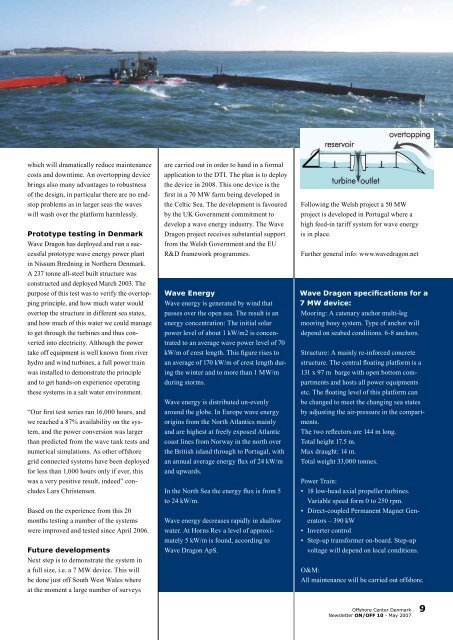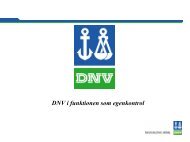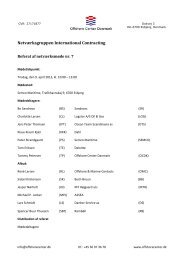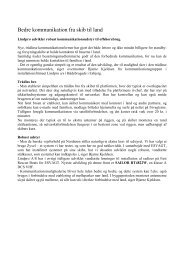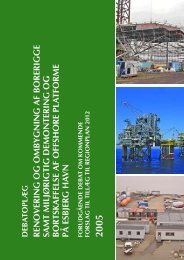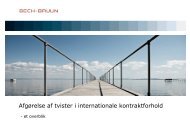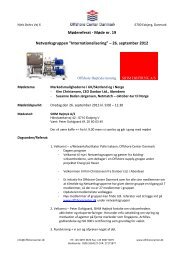Create successful ePaper yourself
Turn your PDF publications into a flip-book with our unique Google optimized e-Paper software.
which will dramatically reduce maintenance<br />
costs and downtime. An overtopping device<br />
brings also many advantages to robustness<br />
of the design, in particular there are no endstop<br />
problems as in larger seas the waves<br />
will wash over the platform harmlessly.<br />
Prototype testing in Denmark<br />
Wave Dragon has deployed and run a successful<br />
prototype wave energy power plant<br />
in Nissum Bredning in Northern Denmark.<br />
A 237 tonne all-steel built structure was<br />
constructed and deployed March 2003. The<br />
purpose of this test was to verify the overtopping<br />
principle, and how much water would<br />
overtop the structure in different sea states,<br />
and how much of this water we could manage<br />
to get through the turbines and thus converted<br />
into electricity. Although the power<br />
take off equipment is well known from river<br />
hydro and wind turbines, a full power train<br />
was installed to demonstrate the principle<br />
and to get hands-on experience operating<br />
these systems in a salt water environment.<br />
“Our first test series ran 16,000 hours, and<br />
we reached a 87% availability on the system,<br />
and the power conversion was larger<br />
than predicted from the wave tank tests and<br />
numerical simulations. As other offshore<br />
grid connected systems have been deployed<br />
for less than 1,000 hours only if ever, this<br />
was a very positive result, indeed” concludes<br />
Lars Christensen.<br />
Based on the experience from this 20<br />
months testing a number of the systems<br />
were improved and tested since April 2006.<br />
Future developments<br />
Next step is to demonstrate the system in<br />
a full size, i.e. a 7 MW device. This will<br />
be done just off South West Wales where<br />
at the moment a large number of surveys<br />
are carried out in order to hand in a formal<br />
application to the DTI. The plan is to deploy<br />
the device in 2008. This one device is the<br />
first in a 70 MW farm being developed in<br />
the Celtic Sea. The development is favoured<br />
by the UK Government commitment to<br />
develop a wave energy industry. The Wave<br />
Dragon project receives substantial support<br />
from the Welsh Government and the EU<br />
R&D framework programmes.<br />
Wave Energy<br />
Wave energy is generated by wind that<br />
passes over the open sea. The result is an<br />
energy concentration: The initial solar<br />
power level of about 1 kW/m2 is concentrated<br />
to an average wave power level of 70<br />
kW/m of crest length. This figure rises to<br />
an average of 170 kW/m of crest length during<br />
the winter and to more than 1 MW/m<br />
during storms.<br />
Wave energy is distributed un-evenly<br />
around the globe. In Europe wave energy<br />
origins from the North Atlantics mainly<br />
and are highest at freely exposed Atlantic<br />
coast lines from Norway in the north over<br />
the British island through to Portugal, with<br />
an annual average energy flux of 24 kW/m<br />
and upwards.<br />
In the North Sea the energy flux is from 5<br />
to 24 kW/m.<br />
Wave energy decreases rapidly in shallow<br />
water. At Horns Rev a level of approximately<br />
5 kW/m is found, according to<br />
Wave Dragon ApS.<br />
Following the Welsh project a 50 MW<br />
project is developed in Portugal where a<br />
high feed-in tariff system for wave energy<br />
is in place.<br />
Further general info: www.wavedragon.net<br />
Wave Dragon specifications for a<br />
7 MW device:<br />
Mooring: A catenary anchor multi-leg<br />
mooring bouy system. Type of anchor will<br />
depend on seabed conditions. 6-8 anchors.<br />
Structure: A mainly re-inforced concrete<br />
structure. The central floating platform is a<br />
131 x 97 m barge with open bottom compartments<br />
and hosts all power equipments<br />
etc. The floating level of this platform can<br />
be changed to meet the changing sea states<br />
by adjusting the air-pressure in the compartments.<br />
The two reflectors are 144 m long.<br />
Total height 17.5 m.<br />
Max draught: 14 m.<br />
Total weight 33,000 tonnes.<br />
Power Train:<br />
• 18 low-head axial propeller turbines.<br />
Variable speed form 0 to 250 rpm.<br />
• Direct-coupled Permanent Magnet Generators<br />
– 390 kW<br />
• Inverter control<br />
• Step-up transformer on-board. Step-up<br />
voltage will depend on local conditions.<br />
O&M:<br />
All maintenance will be carried out offshore.<br />
<strong>Offshore</strong> <strong>Center</strong> Denmark<br />
Newsletter <strong>ON</strong>/<strong>OFF</strong> 10 - May 2007<br />
9


